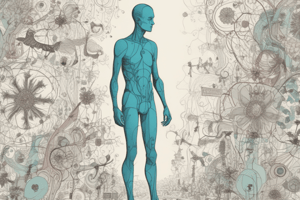Podcast
Questions and Answers
Case-control pairs that had the same exposure are termed ______________________.
Case-control pairs that had the same exposure are termed ______________________.
concordant
Case-control pairs with different exposure experience are termed ____________________________________.
Case-control pairs with different exposure experience are termed ____________________________________.
discordant pairs
Regarding the 2 x 2 table for matched pairs for case-control studies, explain the a and b pairs.
Regarding the 2 x 2 table for matched pairs for case-control studies, explain the a and b pairs.
a pairs are pairs in which both the case and the control were exposed; b pairs are pairs in which the case was exposed and the control was not.
Calculation of the odds ratio in such a matched pair study is based on the _____________________ pairs, and these are the _____ and ________ pairs.
Calculation of the odds ratio in such a matched pair study is based on the _____________________ pairs, and these are the _____ and ________ pairs.
Matched pairs odds ratio equals ________________________.
Matched pairs odds ratio equals ________________________.
The odds ratio matched pairs formula consists of:
The odds ratio matched pairs formula consists of:
In the matched pairs 2 x 2 table: a pairs are in the ______________; b pairs are in the ________________; c pairs are in the __________________; and d pairs are in the _____________________.
In the matched pairs 2 x 2 table: a pairs are in the ______________; b pairs are in the ________________; c pairs are in the __________________; and d pairs are in the _____________________.
Cross sectional studies are studies in which ____________________ and ____________________ are collected ____________________________.
Cross sectional studies are studies in which ____________________ and ____________________ are collected ____________________________.
With cross sectional studies, it is as if we are viewing ____________________________________________.
With cross sectional studies, it is as if we are viewing ____________________________________________.
What is an important consideration to include in case control studies?
What is an important consideration to include in case control studies?
What is a problem with the use of incident cases in case control studies?
What is a problem with the use of incident cases in case control studies?
Which type of case obtains better results?
Which type of case obtains better results?
Why does one type of case obtain better results?
Why does one type of case obtain better results?
Which cases are more likely to obtain longer-term survivors? Why?
Which cases are more likely to obtain longer-term survivors? Why?
What is the formula for prevalence cases?
What is the formula for prevalence cases?
What is the formula for prevalence of controls?
What is the formula for prevalence of controls?
Are there biases that are possible with case control studies?
Are there biases that are possible with case control studies?
What is recall bias?
What is recall bias?
Is recall bias more or less serious than other types of bias?
Is recall bias more or less serious than other types of bias?
Recall bias has to do with ___________________________________. Give an example.
Recall bias has to do with ___________________________________. Give an example.
The quality of the data in case control studies is to some extent determined by _________________________________.
The quality of the data in case control studies is to some extent determined by _________________________________.
Recall bias may occur when ______________________________?
Recall bias may occur when ______________________________?
Recall bias may result in either __________________________ or __________________________________ of the association between exposure and outcome.
Recall bias may result in either __________________________ or __________________________________ of the association between exposure and outcome.
Give examples of when selection bias can occur.
Give examples of when selection bias can occur.
What problems must be kept in mind to avoid selection bias? What are they?
What problems must be kept in mind to avoid selection bias? What are they?
Give another example of a problem to avoid concerning selection bias.
Give another example of a problem to avoid concerning selection bias.
Is it difficult to select appropriate controls in epidemiology?
Is it difficult to select appropriate controls in epidemiology?
The way the controls are selected is a major determinant in whether ___________________________________.
The way the controls are selected is a major determinant in whether ___________________________________.
What is another type of bias in case control studies?
What is another type of bias in case control studies?
Why can observation bias occur?
Why can observation bias occur?
What is observation bias?
What is observation bias?
Give an example of observation bias.
Give an example of observation bias.
What does misclassification bias have to do with?
What does misclassification bias have to do with?
How many forms of misclassification bias are there and what are they?
How many forms of misclassification bias are there and what are they?
Explain how case control and exposure data can be misclassified.
Explain how case control and exposure data can be misclassified.
Explain about differential misclassification. Give an example.
Explain about differential misclassification. Give an example.
What does nondifferential misclassification result from, and what is the inherent problem?
What does nondifferential misclassification result from, and what is the inherent problem?
What is the usual effect of nondifferential misclassification?
What is the usual effect of nondifferential misclassification?
Nondifferential misclassification happens when ______________________________________________.
Nondifferential misclassification happens when ______________________________________________.
In case control studies, nondifferential misclassification can happen when _____________________________________.
In case control studies, nondifferential misclassification can happen when _____________________________________.
What is differential misclassification?
What is differential misclassification?
Which is more serious: differential misclassification or nondifferential misclassification?
Which is more serious: differential misclassification or nondifferential misclassification?
Nondifferential misclassification happens to exposure or disease in the same or different proportions?
Nondifferential misclassification happens to exposure or disease in the same or different proportions?
Is nondifferential misclassification random or non-random?
Is nondifferential misclassification random or non-random?
Nondifferential misclassification ________________________________ true relation of risk, and it is biased towards ____________________________.
Nondifferential misclassification ________________________________ true relation of risk, and it is biased towards ____________________________.
Information bias can occur when _______________________________ about the subjects in the study ____________________________________.
Information bias can occur when _______________________________ about the subjects in the study ____________________________________.
What results when information about the subjects is inadequate?
What results when information about the subjects is inadequate?
What are the strengths of case control studies?
What are the strengths of case control studies?
What are the weaknesses of case control studies?
What are the weaknesses of case control studies?
What is the measure of association used in case control studies called?
What is the measure of association used in case control studies called?
Regarding measures of association used in case control studies, what is this used in place of? Why?
Regarding measures of association used in case control studies, what is this used in place of? Why?
What can be used instead of relative risk?
What can be used instead of relative risk?
In a case control study, do we know the incidence in the exposed or the non-exposed population? Why?
In a case control study, do we know the incidence in the exposed or the non-exposed population? Why?
Does the odds ratio allow us to obtain a good estimate of the relative risk?
Does the odds ratio allow us to obtain a good estimate of the relative risk?
How can the odds of an event in epidemiology be defined?
How can the odds of an event in epidemiology be defined?
Is there a difference between probability and odds?
Is there a difference between probability and odds?
Can we calculate the relative risk directly to determine if there is an association between exposure and disease? Why?
Can we calculate the relative risk directly to determine if there is an association between exposure and disease? Why?
By using the odds ratios, what questions do we ask?
By using the odds ratios, what questions do we ask?
How can we calculate the odds ratio?
How can we calculate the odds ratio?
Give the formula for the odds ratio.
Give the formula for the odds ratio.
The odds ratio can be interpreted the same way as ______________________________.
The odds ratio can be interpreted the same way as ______________________________.
If the exposure is not related to the disease, the odds ratio will equal _______.
If the exposure is not related to the disease, the odds ratio will equal _______.
If the exposure is positively related to the disease, the odds ratio will be ______________________________.
If the exposure is positively related to the disease, the odds ratio will be ______________________________.
If the exposure is negatively related to the disease, the odds ratio will be _________________________.
If the exposure is negatively related to the disease, the odds ratio will be _________________________.
The odds of case exposure is written as _________________________.
The odds of case exposure is written as _________________________.
How do you write the odds of control exposure?
How do you write the odds of control exposure?
What is the formula for odds ratio in general?
What is the formula for odds ratio in general?
If odds ratio = 1, then exposure is ______________________.
If odds ratio = 1, then exposure is ______________________.
If odds ratio > 1, then exposure is ______________________.
If odds ratio > 1, then exposure is ______________________.
If odds ratio < 1, then exposure is _______________________ .
If odds ratio < 1, then exposure is _______________________ .
In a case control study, only the odds ratio can be calculated as _____________________________________________.
In a case control study, only the odds ratio can be calculated as _____________________________________________.
The odds ratio is a good approximation of the relative risk in the population when:
The odds ratio is a good approximation of the relative risk in the population when:
In selecting the study population in case control studies, controls are often selected by ______________________________.
In selecting the study population in case control studies, controls are often selected by ______________________________.
In case control studies, the results are then analyzed in terms of ______________________________________.
In case control studies, the results are then analyzed in terms of ______________________________________.
Considering this, if a person is either exposed or not exposed, then there are only ____________ types of case-control pairs that are possible regarding case-control combinations in regards to exposure history.
Considering this, if a person is either exposed or not exposed, then there are only ____________ types of case-control pairs that are possible regarding case-control combinations in regards to exposure history.
The ___________ types of case-control pairs include __________ types that are listed as ____________________________ pairs, and ___________ types that are listed as _____________________ pairs.
The ___________ types of case-control pairs include __________ types that are listed as ____________________________ pairs, and ___________ types that are listed as _____________________ pairs.
The two types of concordant pairs include the following:
The two types of concordant pairs include the following:
The two types of discordant pairs include the following:
The two types of discordant pairs include the following:
Flashcards are hidden until you start studying
Study Notes
Case Control Studies
- Important to decide between using incident (new) cases or prevalent (existing) cases.
- Incident cases yield better results despite practical challenges; they reduce potential confounding from survival bias.
- Prevalent cases may skew results by including long-term survivors who may not represent all patients.
Bias in Case Control Studies
- Multiple biases exist:
- Recall Bias: Involves differential recall of exposure between cases and controls; can suggest false relationships.
- Selection Bias: Occurs when study groups differ; impacts generalizability, especially if cases are drawn from a single source.
- Observation Bias: Results from investigator's knowledge influencing data collection and interpretation.
- Misclassification Bias: Errors in categorization of exposure or disease status; can be differential or nondifferential.
Recall Bias
- More severe than other biases; arises from varying ability to recall past exposures.
- May lead to under or overestimation of associations between exposure and outcomes.
Selection Bias
- Selection methods must ensure controls are representative; using a single institution may limit generalizability.
- Unique characteristics of patients with severe conditions may not reflect the broader population.
Misclassification Bias
- Two forms exist:
- Differential: Misclassification varies between study groups.
- Nondifferential: Inaccuracy is consistent across groups, typically diluting the observed association.
Odds Ratios
- Measure of association in case control studies, used instead of relative risk since the latter cannot be calculated directly.
- Defined as the ratio of the odds of exposure in cases to the odds of exposure in controls.
- Interpreted similarly to relative risk:
- Odds Ratio = 1 implies no relationship.
- Odds Ratio > 1 indicates a positive relationship.
- Odds Ratio < 1 signifies a negative relationship.
Strengths and Weaknesses of Case Control Studies
- Strengths:
- Cost-effective and fast to conduct.
- Suitable for rare diseases and long latency periods.
- Can assess multiple risk factors for diseases.
- Weaknesses:
- Ineffective for rare exposures; challenging to establish temporal relationships.
- Prone to selection and recall biases.
Matched Pairs in Case Control Studies
- Controls are often matched to cases based on known risk factors.
- Analyzed in terms of case-control pairs, focusing on concordant (same exposure) and discordant (different exposure) pairs.
- Calculation of odds ratios primarily relies on discordant pairs.
Formulae in Case Control Studies
- Prevalence Formula: Number of exposed cases / Total number of cases.
- Odds Ratio: calculated as (a/c) / (b/d) or ad / bc.
- Matched Pairs Odds Ratio: Calculated using discordant pairs (b and c).
Research Considerations
- Careful selection of appropriate controls is critical to enforcing reliability in study results.
- Data quality relies heavily on accurate recall from the patients involved.
- Results analyzed with attention to pairs, enhancing the interpretation of exposure effects.### Matched Pairs 2 x 2 Table
- In a matched pairs 2 x 2 table, specific pairs of data are categorized into four distinct quadrants.
- The quadrants are identified as:
- Top left box contains 'a' pairs.
- Top right box contains 'b' pairs.
- Bottom left box contains 'c' pairs.
- Bottom right box contains 'd' pairs.
Cross Sectional Studies
- Cross sectional studies involve collecting exposure and outcome data simultaneously.
- They provide a snapshot or representation of a specific moment in time.
- These studies allow researchers to examine relationships between variables at one point, but do not establish causation.
Snapshot Perspective
- Cross sectional studies can be viewed as capturing a snapshot of the entire population at a particular moment, highlighting the status of various variables concurrently.
Studying That Suits You
Use AI to generate personalized quizzes and flashcards to suit your learning preferences.





